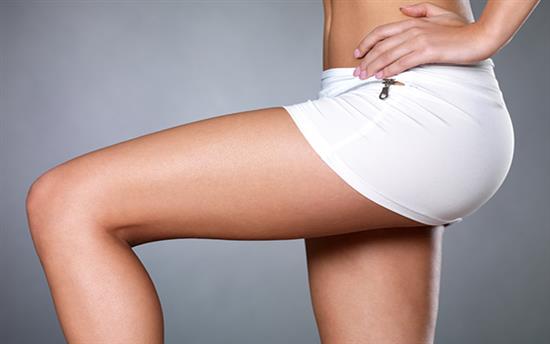
Losing a large amount of weight can be an intensely rewarding experience, however, for many men and women sudden weight loss can result in a considerable amount of excess skin; the reason for this is that being overweight stretches the skin to accommodate the extra fat stores. When weight is lost, the fat reduces but the skin has lost its elasticity and does not retract resulting in loose unsightly skin folds. The thighs are very commonly affected as part of this process resulting in loose skin, which causes folds and rubbing between the legs, that can be uncomfortable and sometimes painful, which is where thigh lift surgery comes in.
Thigh lift surgery after weight loss is designed to remove excess skin and fat from the upper inner thighs. In some cases, liposuction is also required to achieve the desired outcome and this is usually carried out at the same time. It does not improve the loose skin at the outer thighs and hips. It also does not improve the loose skin which may accumulate just above the knee.
Information on Thigh Lift Surgery with Dr Chana
Thigh lift surgery after weight loss is carried out under a general anaesthetic and usually requires a stay in the hospital. During the surgery, Dr. Chana will remove the loose skin from just below the groin area and usually along the length of the inner, upper thigh. The scar is quite long and T-shaped, with the upper horizontal scar in the groin crease and the vertical scar extending down the inside of the thigh a variable distance. In severe cases, this can extend down to the knee.
It should be noted that in weight loss patients a mini-thigh lift with its limited groin crease scar is not suitable.
Following the thigh lift surgery, you will recover in hospital for one night. Wound dressings and a supportive compression garment may be given to you prior to you going home. Patients will likely be prescribed painkillers and you should take these regularly for the first few days.
The thigh lift is an invasive surgical procedure, and therefore you are likely to have some discomfort, swelling and bruising on and around your thighs. Occasionally the bruising and swelling can extend down the legs to the level of the ankles as a result of the effects of gravity, and this is entirely normal. Dr. Chana will advise you about your aftercare both before and after surgery, along with how long you are required to wear your supportive compression garment.
You will receive a follow-up consultation after your surgery at which Dr. Chana will assess your progress. It’s advised you avoid vigorous exercise and heavy lifting for 4 to 6 weeks post thigh lift surgery, and should take a minimum of one-two weeks is taken away from work, although you should determine this based on the nature of your work. If you’ve undergone multiple skin removal surgeries (for example, a thigh lift in combination with a tummy tuck) you may need to reassess your recovery time.
It takes some time for the scars to fully mature; although the scars may be somewhat pink in appearance during the first few months, they will fade in time with the normal maturation process taking well over a year.
Thigh lifts after weight loss is a common procedure for Dr. Chana and is generally considered a safe cosmetic procedure when in the right hands. However, as with all surgical procedures, thigh lift surgery carries an element of risk. An unexpected reaction to the anaesthetic, excessive bleeding, risk of infection and developing a blood clot are all rare but recognised risks when undergoing surgery.
A fluid collection, called a Seroma, can occur even a few weeks after the surgery; this is a collection of clear fluid, not blood, and will easily be diagnosed during follow up visits and removed by aspirating it with a needle in the clinic.
Since the scars are long there are often parts of the wound that may be slow to heal. Often this is at the T-junction of the scar in the groin crease. This area will ultimately heal but may need more attention with dressings. Lumpy scars, which are called hypertrophic or keloid scars, can also occur but are unusual in Caucasian individuals.
There may be some loss of sensation are areas adjacent to the scar but this usually returns to normal over a period of several months. A patient should be aware that although they will be left with visible scars along the inner thigh following thigh lift surgery, most patients see this as a fair trade for not having excess, sagging skin.
Good to know
Thigh lift surgery after substantial weight loss can also be combined with other surgical procedures, including Abdominoplasty (tummy tuck), Brachioplasty (arm lift) and buttock lifting, depending on individual circumstances; it has to be remembered that combining surgical procedures can lengthen the operating time and comes with increased risk.
Each case is assessed individually and in some situations, combination surgery is not advisable. These are invasive surgical procedures, and a full consultation is essential in order to determine what options are available to you, as well as the risks and complications associated with this type of surgery.
